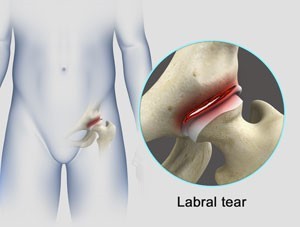Understanding Hip Labral Tears
A hip labral tear involves damage to the labrum, a ring of cartilage that follows the outside rim of the hip joint socket. The labrum acts as a cushion and helps to secure the head of the femur (thigh bone) within the acetabulum (hip socket). When this cartilage tears, it can cause significant pain and impact hip function, affecting athletes and active individuals, as well as those with structural hip issues.
.
Symptoms and Diagnosis
Symptoms of a hip labral tear often include:
– Deep hip or groin pain, sometimes radiating to the buttocks or down the leg.
– A clicking, locking, or catching sensation in the hip joint.
– Stiffness or limited range of motion in the hip.
Diagnosis typically involves a combination of patient history, physical examinations, and imaging tests such as MRI or MR arthrography, which can provide detailed images of the hip labrum and surrounding structures.
.
.
Physiotherapy Treatment for Hip Labral Tears
.
Physiotherapy is essential in managing hip labral tears, whether as a primary treatment approach or as part of post-surgical rehabilitation. Here’s a comprehensive guide to physiotherapy treatment:
1. Pain Management and Initial Rest
– Activity Modification: Avoid activities that exacerbate pain, particularly those involving hip rotation and deep flexion.
– Pain Relief: Use ice therapy and non-steroidal anti-inflammatory drugs (NSAIDs) as recommended by a healthcare professional.
2. Restore Range of Motion
– Gentle Stretching: Focus on hip flexors, extensors, and rotators to improve flexibility without aggravating the tear.
– Joint Mobilization: Manual therapy techniques to reduce joint stiffness and improve movement.
3. Strengthening Exercises
– Core Stability: Strengthen the core muscles to support the hip joint. Exercises such as planks and bridges are effective.
– Hip Stabilizers: Target the gluteal muscles, particularly the gluteus medius, to enhance hip stability. Side-lying leg raises and clamshells are beneficial.
4. Neuromuscular Training
– Proprioceptive Exercises: Enhance balance and coordination with exercises like single-leg stands and the use of balance boards.
– Functional Movements: Incorporate exercises that mimic daily activities or sports-specific movements to ensure a smooth transition back to normal activities.


